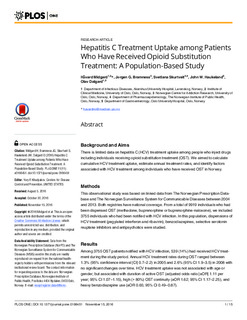Hepatitis C Treatment Uptake among Patients Who Have Received Opioid Substitution Treatment: A Population-Based Study
Peer reviewed, Journal article
Permanent lenke
http://hdl.handle.net/11250/2429500Utgivelsesdato
2016Metadata
Vis full innførselSamlinger
- Artikler [5068]
- Publikasjoner fra CRIStin FHI [7544]
Sammendrag
Background and Aims There is limited data on hepatitis C (HCV) treatment uptake among people who inject drugs including individuals receiving opioid substitution treatment (OST). We aimed to calculate cumulative HCV treatment uptake, estimate annual treatment rates, and identify factors associated with HCV treatment among individuals who have received OST in Norway. Methods This observational study was based on linked data from The Norwegian Prescription Database and The Norwegian Surveillance System for Communicable Diseases between 2004 and 2013. Both registries have national coverage. From a total of 9919 individuals who had been dispensed OST (methadone, buprenorphine or buprenorphine-naloxone), we included 3755 individuals who had been notified with HCV infection. In this population, dispensions of HCV treatment (pegylated interferon and ribavirin), benzodiazepines, selective serotonin reuptake inhibitors and antipsychotics were studied. Results Among 3755 OST patients notified with HCV infection, 539 (14%) had received HCV treatment during the study period. Annual HCV treatment rates during OST ranged between 1.3% (95% confidence interval [CI] 0.7-2.2) in 2005 and 2.6% (95% CI 1.9-3.5) in 2008 with no significant changes over time. HCV treatment uptake was not associated with age or gender, but associated with duration of active OST (adjusted odds ratio [aOR] 1.11 per year; 95% CI 1.07-1.15), high (> 80%) OST continuity (aOR 1.62; 95% CI 1.17-2.25), and heavy benzodiazepine use (aOR 0.65; 95% CI 0.49-0.87). Conclusions Cumulative HCV treatment uptake among OST patients notified with HCV infection in Norway between 2004 and 2013 was 14%. Annual treatment rates during OST remained unchanged below 3% per year. High continuity of OST over time and absence of heavy benzodiazepine use predicted HCV treatment uptake. Increased awareness for HCV among OST patients is needed as tolerable and efficient directly acting antiviral treatment is being introduced.
